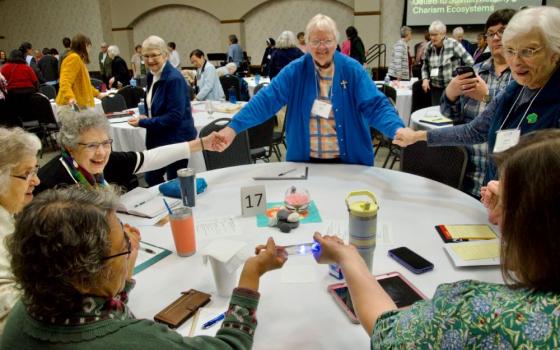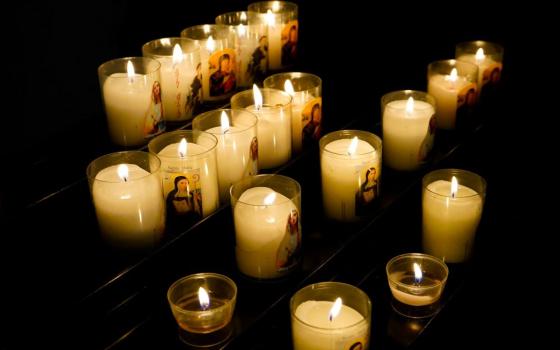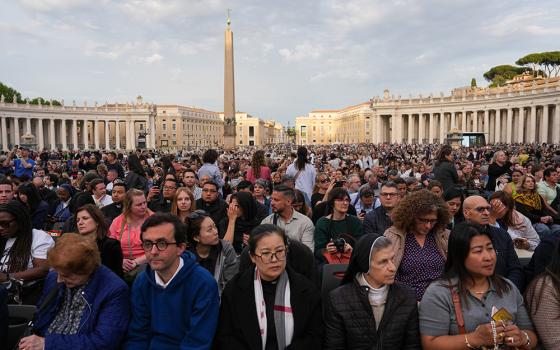
Mercy Sr. Joan Serda works with kindergartner Max on March 16 at St. Pius X Catholic School in Mobile, Alabama. The two are seen through bean-plant seedlings students are growing in the classroom. (GSR photo/Dan Stockman)
It's a quiet weekday morning, and kindergartner Max has stepped out of his busy classroom at St. Pius X in Mobile, Alabama, to work with Mercy Sr. Joan Serda on his reading.
English is not his first language, and his family has moved a lot, so he is behind in school. But Serda is helping him catch up, going through a stack of reading cards.
"Can you see a picture of a bun? Good!" she says, encouraging his successes and gently guiding his failures. "There we go!"
Next are two more kindergartners, then a third-grader working on his reading and short vowel sounds, his feet swinging back and forth under the low table.
'My community is named for Divine Providence, so we trust totally in God, but I've never experienced people who trust in God for their entire lives, their everything.'
—Sr. Mary Agnes Cashman
Though the modern school building is nestled in a suburban neighborhood, Serda's tutoring is just one aspect of a long, rich tradition of women religious ministering in the Deep South.
For two centuries, women religious have been moving to the South to open schools and hospitals, serve those made poor and African Americans turned away from other institutions, and work to dispel the grinding poverty that affects so many.
Four Daughters of Charity arrived on the Gulf Coast from Maryland on Dec. 16, 1841, to establish a ministry in response to a request by Mobile's first bishop, Michael Portier, who had asked them to care for the children left orphaned by the yellow fever epidemics that ravaged the area in the early 1800s. By 1852, the sisters were also working as nurses in the local hospital and opened their own by 1855. Today, Ascension Providence is a 349-bed, full-service hospital and trauma center.

Mercy Sr. Joan Serda works with kindergartners Ella, left, and Jaden on March 16 at St. Pius X Catholic School in Mobile, Alabama. (GSR photo/Dan Stockman)
Some needs have changed since the 1800s, but many have not, and few have gone away.
"Poverty in the South is very different than poverty in the North," said Sr. Chris Pologa of the Sisters of St. Joseph of Carondelet, who has worked at a Catholic girls' school in Baton Rouge, Louisiana, for about 14 years. "In the North, a lot of the poverty is urban. It's poverty, but at least there's resources. In the South, it's rural poverty, and even where there are services, a lot of people don't have transportation to get to them."
There are backwoods areas in Louisiana, Mississippi and Alabama that haven't changed since the Civil War, she said: "The roads aren't paved. They're one step above subsistence living."
Nine of the 10 states with the highest poverty rates in the nation are in the South. In Mississippi, more than 1 in every 4 children lives in poverty, which the federal government defines as a family of four living on $30,000 or less a year. These areas often have a lack of health care, little or no public transportation, little or no access to banking opportunities, and few options to buy healthy food.
Pologa said she is proud to be part of such a long, rich tradition of sisters.
"It's an honor to stand on their shoulders," she said. "It's not about the buildings. It's about the relations and the community spirit. ... We go where the need is."
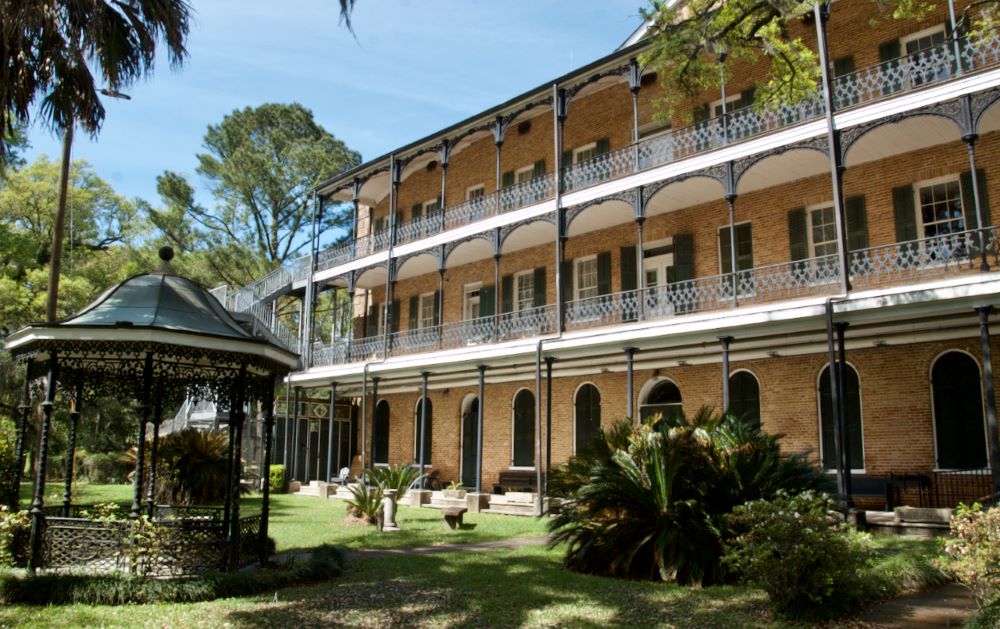
The Visitation Monastery in Mobile, Alabama, in March. The building originally housed the order's school but has been a retreat center since the 1950s. (GSR photo/Dan Stockman)
The four Daughters of Charity were far from the first sisters to travel to the South to minister. They weren't even the first in Mobile.
In 1832, nine years before the Daughters of Charity arrived, Portier asked the Georgetown Visitation sisters to help with the region's lack of schools. Five sisters moved from Washington, D.C., to Mobile in December, and by January 1833, they were running a school with 40 students.
The Academy of the Visitation taught students in Mobile for 120 years, despite a tornado in 1840 and a fire in 1854. But by the 1940s, the costs of running the school were rising, and there were few vocations of young women to become teachers. The high school closed in 1948 and the grammar school in 1952. Shortly after, the school building was converted to a retreat house, and the cloistered sisters have been hosting retreatants ever since.
Inside the walls of the Visitation monastery grounds, time seems to stand still beneath the spreading oak trees. The sisters spend three to four hours a day in prayer, but when it fits in their schedule, they like to attend Mass with the retreatants.
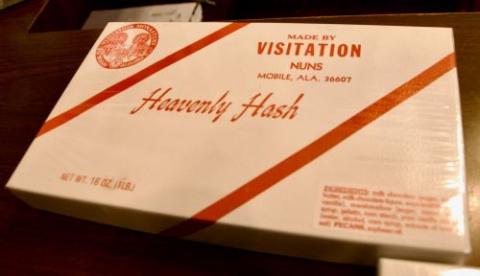
Heavenly Hash, the chocolate, peanut and marshmallow confection made by the Visitation sisters, is for sale in the monastery's gift shop in Mobile, Alabama. The candy is a popular gift and often sells out at Christmastime. (GSR photo/Dan Stockman)
"Different people have different ways of celebrating the Mass, different songs, and we like to experience that," Sr. Rose Marie Kinsella said.
There are 22 sisters today, with the youngest in her late 30s, but "we're not really conscious of age," she said. "We lead a regular life."
And though they are cloistered and no longer have a school, the Visitation sisters in Mobile still have a wide reach. In 1957, they established a candy kitchen, and their Heavenly Hash, a confection of marshmallow and peanuts covered in milk chocolate, is still so popular that it regularly sells out at Christmastime, when corporations buy it by the case to give to clients and employees.
The sisters make the candy, buying chocolate in 25-pound blocks but making their own marshmallow, and volunteers sell it in the monastery gift shop.

The house directly behind the Edmundite Missions building in Selma, Alabama, was reduced to a foundation when a powerful tornado struck the town in January, but the mission buildings suffered almost no damage. (GSR photo/Dan Stockman)
Elsewhere in Alabama, the sisters' ministries to those kept poor are direct and hands-on.
Selma, about three hours north of Mobile, was prosperous before the Civil War but has suffered economically for decades as industry moved away. Today, it is the poorest city in the state, one of the poorest cities in the nation, and 38% of its less than 18,000 residents use food stamps, compared to 12.6% nationwide.
Its main street is home to an abandoned hospital, its windows broken out and mildew growing on the walls. On a recent afternoon, a man slept on the front steps.
Edmundite priests have been ministering in Selma since 1937, and for much of that time, women religious have assisted them. Currently, there are four sisters there: Sr. Mary Agnes Cashman and Sr. Virginia Patrick from the Congregation of Divine Providence in Kentucky and Sr. Kathleen Navarra and Sr. Pat Flass of the Sisters of St. Joseph of Rochester, New York.
Advertisement
As if things weren't challenging enough in Selma, a tornado hit the town Jan. 12, causing significant damage and injuring dozens.
"I walked the neighborhood after the storm, and everyone, I swear, told me how blessed they were," Cashman said. "They would show me their home, which was destroyed, and say they're blessed. That night, I said, 'God, if I came home from work and had no place to live, I don't know that I could say I was blessed.' "
Cashman spent some time ministering in Vredenburgh, Alabama, about an hour south of Selma, a few years ago after she retired from a career in education in Kentucky and elsewhere. Now, she is the education coordinator for the Edmundite Missions in Selma.
"I just fell in love with the people," she said. "Then, Kathy [Navarra] was running summer camps in Selma, so I came down for two weeks to write curriculum for the camps and fell more in love. ... I'm still in love with the people. My community is named for Divine Providence, so we trust totally in God, but I've never experienced people who trust in God for their entire lives, their everything."

Carla Robinson, left, hugs Sr. Mary Agnes Cashman March 15 in Selma, Alabama, after showing Cashman the repairs and donated items she received after a tornado tore off her roof in January. (GSR photo/Dan Stockman)
Carla Robinson is among those trusting in God — and the sisters. Her house is just a block from the Edmundite Missions, and the tornado struck the day she moved in, taking off the roof and collapsing the ceiling. By March, the repair work was almost complete.
"This is all because of y'all," Robinson told Cashman as she gave her a tour of the house and pointed out the furniture, household items and clothes that came from the Edmundite Missions. "That came from y'all, that came from y'all — all this came from y'all."
The Edmundite Missions buildings, which were just feet from houses that the tornado destroyed but suffered almost no damage themselves, are home to a soup kitchen, after-school programming, health clinics, workforce development programs, a thrift store and recreational facilities.
Flass said the poverty is so great and the resources so few that for many people, the doctors who volunteer at the Edmundite health clinics are their primary care physician.
"I don't know where these people would go for health care if we weren't here," Flass said.


